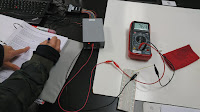
To solve equation, we need to do a calculation with lots of unknowns.
At the end of this class, we will learn another way to solve this question but with fewer unknowns. The method is called Mesh Analysis.
We did a lab to make sure that the nodal analysis work.
Nodal Analysis
1.
In pre-lab, we predicted the voltage V1 and V2
The picture below is the calculation of determining V1 and V2

From the picture, we got V1=2.424 V and V2=4.424 V
Equipment:
1. breadboard
2. some wires
3. voltmeter
4. resistors with resistance 6.8k, 10k, and 22k ohms
5. Analog discovery
2.

The picture above is the basic set up for this lab.
After we connected everything correctly, we measured the voltage across 6.8k ohms resistor and 22k ohms resistor.
We got V1 (measured) = 2.37 V
V2 (measured) = 4.34 V (the pictures below)


3.
We calculated the % error from what we got, and we got:

% error for V1 = 2.07%
% error for V2 = 1.81%
From this lab, we can know that nodal analysis is ok to use.
After this lab, we learned a new method to analyze the circuit which is called mesh analysis.

The picture above is a simple set up of mesh analysis.
In the mesh analysis of a circuit with n meshes, we take the following three steps. 1. Assign mesh currents i1, i2, . . . , in to the n meshes.
2. Apply KVL to each of the n meshes. Use Ohm’s law to express the voltages in terms of the mesh currents.
3. Solve the resulting n simultaneous equations to get the mesh currents.
(from Day 5 Notes Nodal and Mesh Analysisc.pdf)
And we did another example with current source in it

The problem involves the usage of supermesh
A supermesh results when two meshes have a (dependent or independent) current source in common.
(from MESH ANALYSIS WITH CURRENT SOURCES.pdf)
For this problem, we ended up with the answer:
i1=-1.3333
i2=-3.0667
i3=-0.0667
Therefore i0=i2-i3=-1.7333A
Summary
The lab we did today is to make sure that the nodal analysis work, and the result of the lab actually prove that the nodal analysis works but it is hard to do it by hand. Therefore, we leaned a new method to analyze the circuit which is called "Mesh Analysis". This method can make the problem much easier to calculate which means fewer unknowns. The number of meshes would be the same number of unknowns.







































